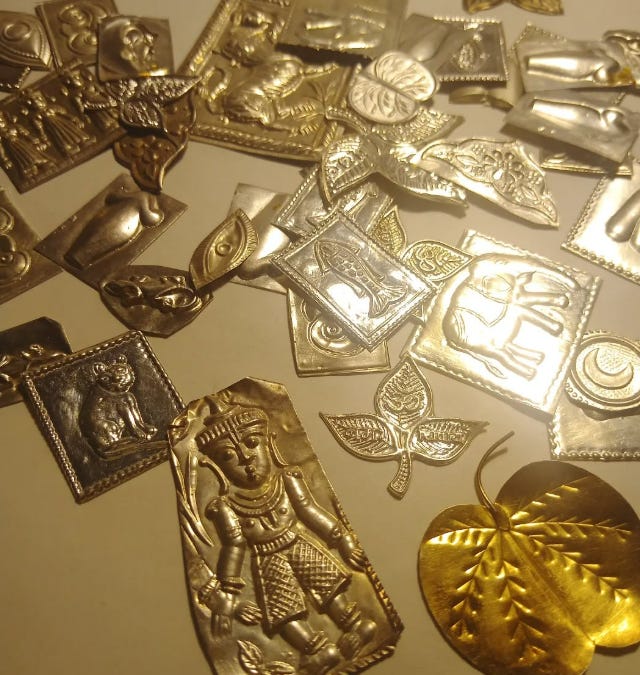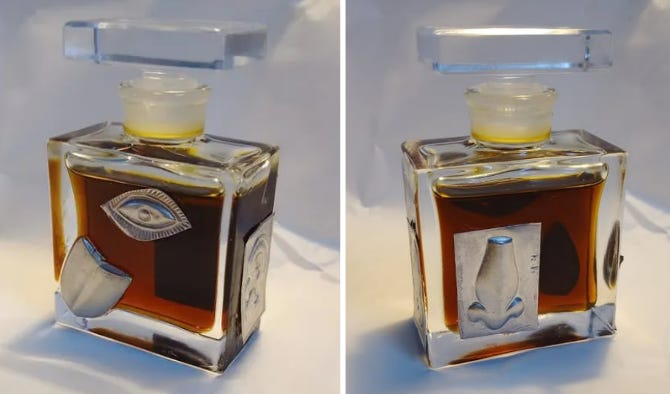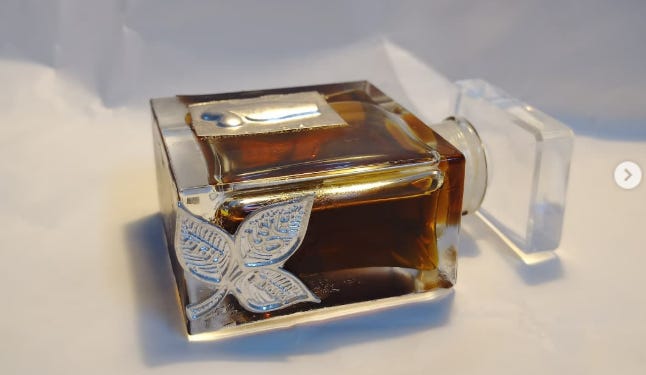Sometimes I have to work backwards from an idea, then sideways, forward, then backwards again.
Last month I wanted to revive an old concept sitting in my brain. What I needed were the ceramic pair of eyes meant to be affixed on deities that I had used before on a custom perfume bottle for my sister to playfully depict her judge-y glare.

These hand-painted pairs of eyes are set on copper. They come in different sizes and shapes. They are meant for tiny baby Krishna idols, and slightly larger ones are affixed on for progressively bigger statues. Some even come with diamond studded eyebrows, or a silver moustache for a male deity.
The best ones though, are pairs designed for angry goddesses! Tilted at a slant, like thin crescent moons, pupils at the centre, appear to glare down upon us. At first, I thought it funny to have a perfume flacon side-eyeing me, questioning all my life choices while I apply perfume on my wrists. Then it dawned on me that the eyes, true to their original intent and purpose, could transform the perfume itself into an invisible layer of fragrant protection that wafts around the wearer’s body. The reason netra-chakshu are glued onto stone or metal idols or even abstract blobs is to awaken them with divine power. Visually, an intimate connection is established, the deity witnesses the devotee’s unwavering faith as they journey through life.
I have been unsuccessful in finding out more about this traditional craft — who makes them, how and where are they made en masse, and why are they so difficult to source?! I went from shop to shop in the old part of Pune city to search for eyes but to no avail! I finally ordered a couple of pairs online. This concept was yet to click into place.
On another day, I visited the old lane of silver shops. Here I had a different type of luck! One uncle had silver plates of individual eyes, nose, tongue, and ears! I have never seen anything like it. From the little I could glean from the shopkeeper, these are sacred "goddess" objects that are kept at the alter, or brought out at certain auspicious occasions for worship. Ok, but which goddess? Sati, the first wife of Lord Shiva?
The silver dismembered eyes, nose, tongues, ears, hands, feet, I held in my hands prompted me to consider this familiar myth.
Sati hears her father has invited all the gods and goddesses to his kingdom to perform a special sacrifice/ yagya. She is puzzled that her husband, Lord Shiva has not been invited.
She goes to his palace on the day to confront her father. He takes the opportunity to insult Shiva further. He is afterall only the guardian of ghouls and snakes. Unable to tolerate such humiliation, she steps into the sacrificial fire.
Shiva finds her charred corpse, picks it up and descends into his dance of madness, scorching the planet in the process. As he moves, parts of Sati's body fall to the earth - eyes, brows, toes, feet, torso, fingers, hands, arms, ears, even her jewellery, her crown, wherever they fell, there sprung a mighty goddess.
While I mulled over this myth, I picked up as much silver as I could afford. Now the more difficult question: how to make it possible to experience Devi's fuming body, the wood-fire, embers and all? What kind of botanical extracts could represent such a sensitive yet potent theme? I had different parts but not the whole body quite yet. So I ran the concept by historian Nicolas Roth who instantly sent me the link to an early 19th century illustration of this exact tale. Titled “Shiva Carrying the Corpse of Sati on His Trident”, this watercolour is in the collection of Los Angeles County Museum of Art (LACMA), USA. This painting is not on public display and the label does not mention if it has ever been on view.

This painting has been so helpful as a visual aid to figure out how the perfume bottle should be adorned, which botanical ingredients should be used to construct this perfume, and why.
The animalic notes offer immediate olfactory cues - Shiva wears the skins of bear, leopard, and tiger. The snake slithered around his neck lends a marine-salty-seaweed note on top of the animal musk. The crescent moon over his thick matted locks, his forehead, chest and arms perhaps scented with sandalwood paste and ash. The metallic trident seared into the charred corpse of Sati, still hot to the touch, still fuming with the scent of incense, wood and camphor. As is illustrated in this painting, Sati chose simple adornments. Living in the hills and mountains away from civilisation, floral notes are absent. There are no cultivated roses here. Maybe she had picked a pink lotus to adorn her hair earlier in the day.

After some careful consideration, I kept the formulation very simple. Extracts of Pink Lotus, Tobacco and Spikenard are the key building blocks for the “Corpse”. Then come the civet, choya nakh (distilled onycha seashells), and ambergris for the animalic musk. Burnt woods and ash accords are built with vetiver, patchouli, opoponax, sandalwood, hiba-wood and balsam.
Each unique edition comes adorned with lightly glued silver facets. Just as in the myth, the silver ears, nose, eyes, lips, or tongue, fall off the corpse-bottle. I would encourage the wearer of this perfume, to take these sacred objects and turn them into talismans that can be worn as pendants, earrings, rings, etc.
“Corpse Flower” comes in a 15ml glass flacon. Each bottle is unique and is priced at USD 350 each. It’s easiest to reserve one by replying to this email. Later in the week I will update 3ml editions ($75 each) on my website.









My god that painting